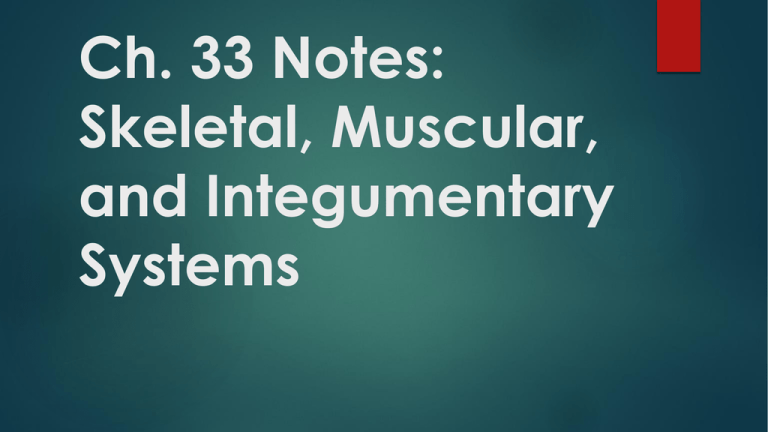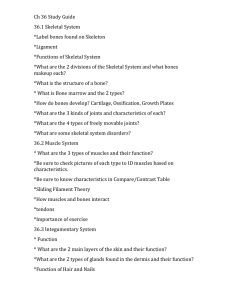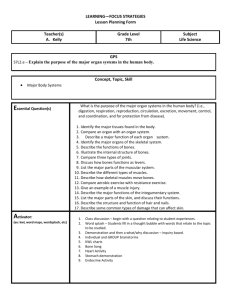Ch. 33 Notes: Skeletal, Muscular, and Integumentary Systems
advertisement

Ch. 33 Notes: Skeletal, Muscular, and Integumentary Systems Objectives 10A describe the interactions that occur among systems that perform the functions of regulation, nutrient absorption, reproduction, and defense from injury or illness in animals; 10C analyze the levels of organization in biological systems and relate the levels to each other and to the whole system; 11A describe the role of internal feedback mechanisms in the maintenance of homeostasis Skeletal System Skeletal System The skeletal system includes bones and tissues that are important for supporting, protecting, and moving your body Also store minerals and produce blood cells Your skeletal system is made up of two systems Appendicular skeleton- limbs and pelvis that aid in movement (white) Axial skeleton- head and spine that support body weight and protect organs (red) Cartilage is a flexible connective tissue found between your bones that allows for smooth movements cartilage Bones connect to form joints Gliding Pivot joints- ankle and wrist joints- all rotation, your head Ball-and-socket legs Saddle Hinge joint- almost any direction- arms and joint- limited ball and socket, like your thumb joint- one directional movement, your knees Bones are living tissue! Compact Spongy bone- hard outer tissues bone- porous tissues that protects the red marrow- site of new blood cell creation Muscular System Muscles are tissues that enable movement Bones Food with the skeletal system through the digestive system Blood through the circulatory system Fluids through the excretory system Humans have 3 types of muscle Skeletal- attached to bones by tendons (a connective tissue), aid in voluntary movement, squared shaped cells with multiple nuclei Smooth- moves food through the digestive system and controls the width of blood vessels. Involuntary muscle with one nucleus Cardiac- found only in the heart, oval shaped cells with many nuclei and lots of mitochondria Note: calcium ions are necessary for muscle contraction (movement) Muscle types SKELETAL MUSCLE SMOOTH MUSCLE CARDIAC MUSCLE Integumentary System The integumentary system has many tissues that protect the body and maintain homeostasis It’s your skin, hair, nails, oil and sweat glands! Protects infection body surface and acts as a barrier against Finger nail!!! Integumentary System Helps to remove substances from the body too Water Salts Urea (pit stains!) Layers Epidermis- outermost layer of skin Made of dead skin cells Keratin- protein that makes skin harder Melanin- dark pigment that absorbs UV light Dermis- inner layer of skin Home of the sweat and oil glands, and hair follicles Regulates body temperature Subcutaneous fat layer Protects and cushions larger blood vessels and neurons, and insulates muscles and organs epidermis hair follicle dermis oil gland pressure receptors Subcutaneous Fat layer sweat gland






